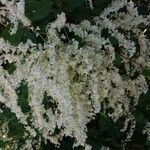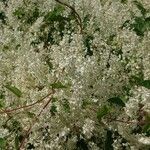Subshrubs. Stems twining, gray-brown, 1-4 m, glabrous. Leaves clustered, rarely solitary; petiole 1.5-2.5 cm; leaf blade narrowly ovate or ovate, 2.5-5 × 1.5-3 cm, both surfaces subleathery, glabrous, base subcordate, margin entire, apex acute; ocrea brown, membranous, oblique, dehiscent. Inflorescence axillary or terminal, paniculate, few branched; peduncle papillate; bracts membranous, apex acute, each 3-6-flowered. Pedicel 3-4 mm, slender, base articulate. Perianth greenish or white, 5-parted; tepals elliptic, outer 3 larger, accrescent and winged on abaxial surface in fruit; wings decurrent below to pedicels; fruiting perianth obovate, 4-5 mm in diam. Stamens 8; filaments dilated below middle, base pubescent. Styles 3, very short; stigmas capitate. Achenes included in persistent perianth, black, slightly shiny, ovoid, trigonous, 3.5-4 mm, densely minutely granular. Fl. Jul-Aug, fr. Aug-Sep.


